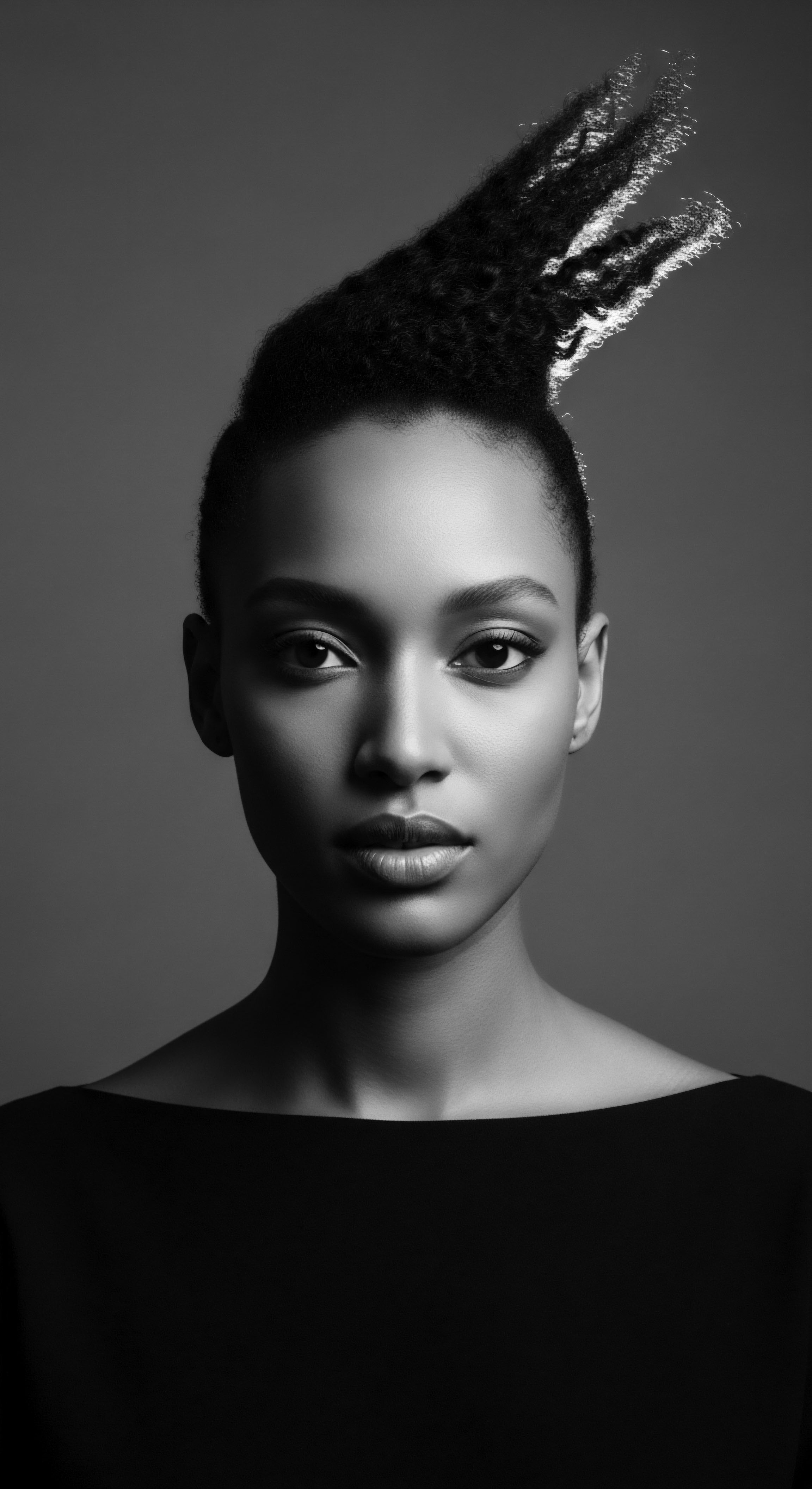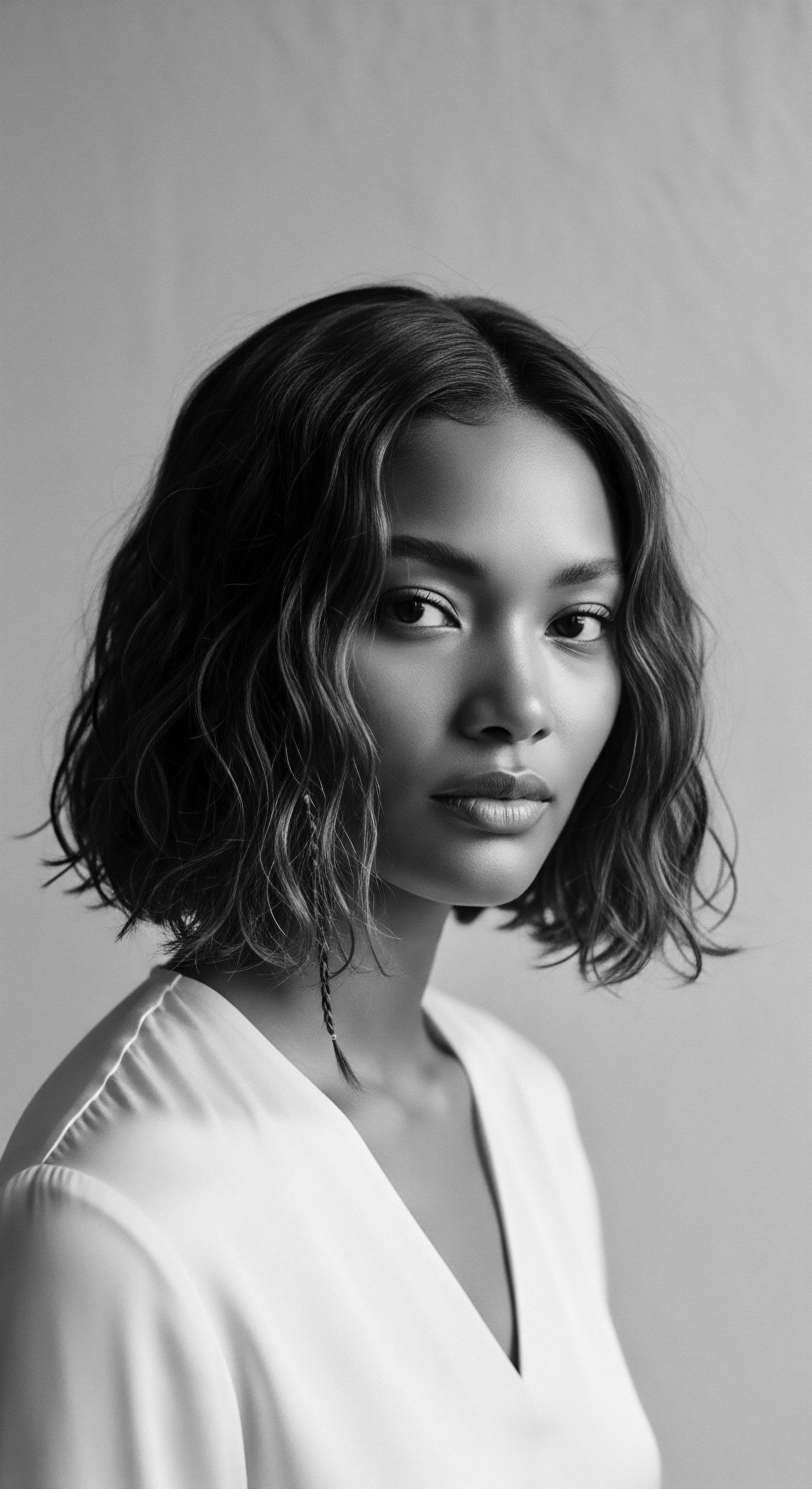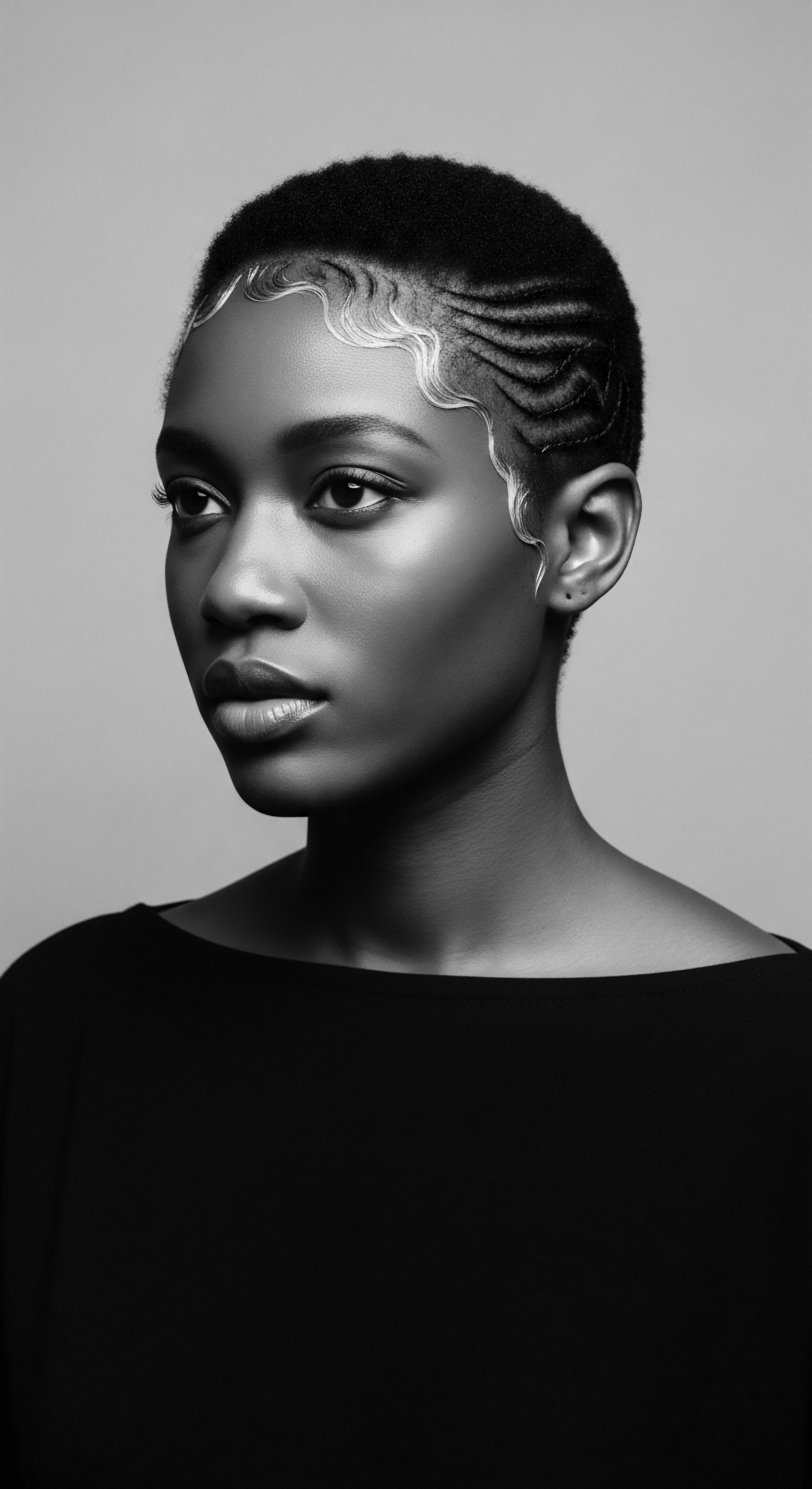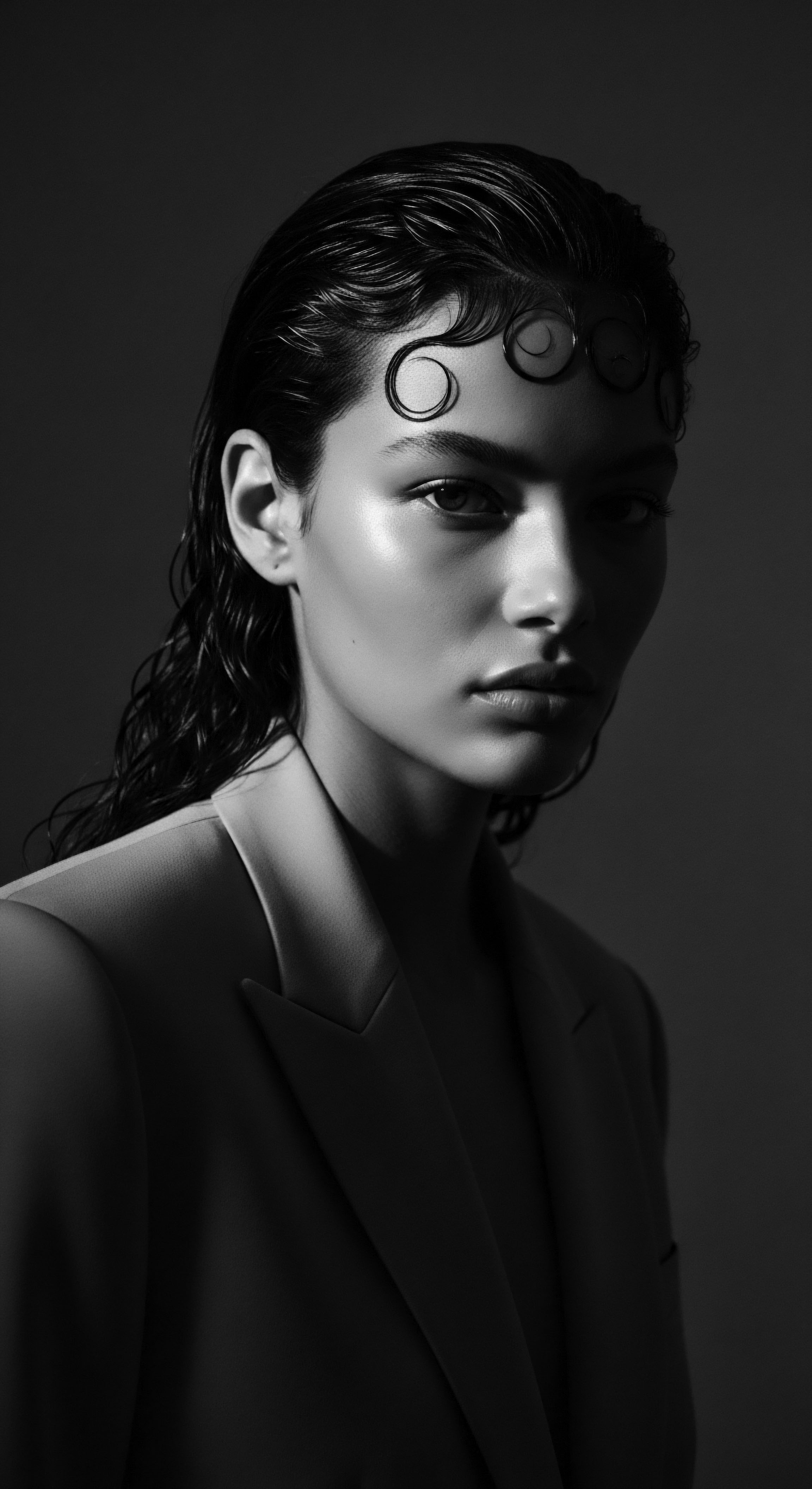
Fundamentals
The Igbo Hair Heritage represents a profound cultural expression rooted in the traditions of the Igbo people of southeastern Nigeria. It is not merely a collection of hairstyles, but a vibrant system of communication, identity, and spiritual connection woven into the very fabric of communal life. This heritage, passed down through generations, encompasses a rich array of styling techniques, adornments, and care practices specifically suited to the unique qualities of textured hair.
For the Igbo, hair has always been considered a crowning glory, a visible signifier of femininity, social standing, and personal expression. The practices associated with Igbo Hair Heritage offer a glimpse into a worldview where physical appearance, particularly hair, serves as a powerful medium for conveying complex societal meanings and ancestral wisdom.
Understanding the Igbo Hair Heritage requires recognizing its foundational meaning as a visual language. Each style, every adornment, and the very act of hair care held specific significance, telling stories of an individual’s journey, their place within the community, and their connection to the spiritual realm. This intricate delineation of identity through hair stands as a testament to the ingenuity and artistic depth of Igbo culture.

Echoes from the Source ❉ Hair as Elemental Biology and Ancient Practices
At its core, the Igbo Hair Heritage begins with the elemental biology of textured hair itself. The tightly coiled and dense nature of Black hair, often perceived through a Western lens as “difficult,” was, in pre-colonial Igbo society, celebrated for its versatility and capacity for sculptural artistry. This intrinsic quality allowed for the creation of diverse and complex coiffures that would be impossible with other hair textures.
The ability of textured hair to hold intricate patterns and shapes, without the aid of modern styling products, meant it served as a living canvas for cultural expression. Ancient Igbo practices recognized this inherent strength, utilizing natural resources for cleansing, conditioning, and styling.
The earliest documented instances of African hair adornment stretch back millennia, with archaeological evidence and historical accounts pointing to a long-standing tradition of hair as a medium for artistic and cultural expression across the continent. For the Igbo, this tradition was deeply integrated into daily life and significant ceremonies. The practice of hair care was often a communal activity, fostering bonds between women and serving as a space for sharing stories and wisdom across generations. This shared ritual underscores the communal aspect of hair heritage, transforming a personal act into a collective experience.
The Igbo Hair Heritage transforms textured hair into a living archive, where each strand holds the echoes of ancestral wisdom and communal narratives.
Traditional Igbo hair care involved natural ingredients sourced from the local environment, demonstrating a deep ecological understanding and sustainable approach to beauty.
- Palm Kernel Oil ❉ This oil, extracted from the seeds of the palm fruit, was a common ingredient, valued for its moisturizing properties and ability to add luster to hair.
- Shea Butter ❉ A staple across many African cultures, shea butter provided deep conditioning and protection against environmental elements, shielding hair from dryness.
- Camwood Powder ❉ Often mixed with palm oil, camwood powder was used not only for its reddish hue but also for its purported benefits to scalp health.
- Charcoal ❉ In some instances, charcoal mixed with palm oil was applied, particularly for creating certain structural hairstyles, though this practice sometimes necessitated cutting the hair to remove it.
These practices highlight a sophisticated understanding of natural emollients and botanicals long before the advent of modern cosmetic science. The selection and application of these ingredients were not random but part of a well-established system of care, passed down through oral tradition and practical demonstration.

Intermediate
Moving beyond a basic understanding, the Igbo Hair Heritage reveals itself as a sophisticated system of social communication and spiritual resonance, where textured hair functions as a dynamic canvas for identity. The significance of Igbo hairstyles extends far beyond mere aesthetics; they served as potent indicators of an individual’s position within the social hierarchy, their marital status, age, and even their occupation or mood. This complex interplay of form and meaning allowed for a nuanced reading of an individual’s life story, communicated through the artistry of their coiffure.

The Tender Thread ❉ Living Traditions of Care and Community
The creation and maintenance of Igbo hairstyles were often communal endeavors, strengthening social bonds and transmitting cultural knowledge. The act of braiding or styling hair was not simply a chore but a cherished ritual, particularly among women. These sessions were opportunities for intergenerational learning, where elders shared stories, advice, and the precise techniques for crafting specific styles.
This shared experience fostered a sense of belonging and continuity, linking individuals to their collective past and future. The meticulous process, often spanning hours, underscores the value placed on hair and the dedication invested in its presentation.
Igbo hair practices were communal expressions of care, weaving personal narratives into the collective memory of a people.
For example, the style known as Isi Owu, a threaded hairstyle, was traditionally worn by young, unmarried girls, signifying their youthfulness and eligibility. The threaded appearance, achieved by wrapping sections of hair with black thread, created a unique texture and allowed for endless variations in pattern. Another notable style, Ojongo, characterized by its crested design and often adorned with feathers, shells, beads, or coins, was popular until the mid-20th century and served as a distinctive feature in Igbo art depicting women. These specific examples illustrate how hairstyles were deeply embedded in the societal structure, serving as a visible language of status and life stage.
The impact of colonial influence and Western beauty standards presented a profound challenge to these established traditions. The introduction of chemical relaxers, hair extensions, and wigs from the late 20th century onwards led to a decline in traditional Igbo hairstyles, as Western ideals of beauty gained prominence. This shift often carried with it a devaluation of natural textured hair, leading to experiences of pain and self-loathing among some Igbo women who were encouraged to alter their natural hair to conform to new standards.
(See also, Johnson & Bankhead, 2014, p. 87) However, a resurgence of interest in traditional Igbo hairstyles has emerged in recent years, with younger generations seeking to reconnect with their heritage and reclaim these ancestral forms of expression.
| Adornment Cowrie Shells |
| Material Source Marine mollusk shells |
| Cultural Significance Symbol of wealth, prosperity, and spiritual connection. Often integrated into styles like Isi Owu. |
| Adornment Beads |
| Material Source Glass, wood, bone, seeds |
| Cultural Significance Indicators of status, beauty, and tribal affiliation. Used to enhance intricate braids and knots. |
| Adornment Threads (Owu) |
| Material Source Natural fibers, often black |
| Cultural Significance Essential for threaded styles (Isi Owu), signifying youth and allowing for sculptural forms. |
| Adornment Feathers |
| Material Source Bird plumage |
| Cultural Significance Symbol of prestige, often used in elaborate styles like Ojongo, indicating high status. |
| Adornment Palm Kernels (Ukpaka) |
| Material Source Seeds of the palm fruit |
| Cultural Significance Used in styles like Ukpaka, representing artistic expression and sometimes royalty. |
| Adornment These adornments were not merely decorative but deeply symbolic, adding layers of meaning to Igbo coiffures and preserving ancestral knowledge. |

Academic
The Igbo Hair Heritage, within an academic framework, is defined as a complex socio-cultural construct, a semiotic system where the manipulation and adornment of textured hair serve as a primary mode of non-verbal communication, encoding intricate layers of individual and collective identity, social stratification, spiritual belief systems, and historical resilience. This definition extends beyond mere aesthetic considerations, positioning Igbo hair practices as a sophisticated ethnographic datum point for understanding indigenous epistemologies concerning the body, beauty, and the sacred. The rigorous examination of this heritage necessitates an interdisciplinary approach, drawing insights from anthropology, ethnobotany, art history, and the sociology of appearance to fully grasp its profound implications.
The inherent structural properties of textured hair, characterized by its helical coils and often denser follicular packing, allowed Igbo artisans to sculpt and mold hair into forms of unparalleled complexity and durability. This biological predisposition was not merely a physical attribute but a foundation upon which a rich cultural meaning was built. The ability of hair to be tightly braided, twisted, and shaped meant it could effectively convey messages that were both ephemeral and enduring.
For instance, the practice of creating Isi Ntukwu, widely recognized today as Bantu knots, involved coiling sections of hair into small, secure knots, frequently embellished with coral beads. This style, beyond its aesthetic appeal, symbolized femininity and cultural identity, bridging ancient traditions with contemporary expressions of self.

The Unbound Helix ❉ Voicing Identity and Shaping Futures
The cultural significance of Igbo hairstyles, as documented in historical and anthropological studies, is manifold. Hair served as a dynamic indicator of life stages and social roles. For example, specific styles distinguished maidens from married women, or indicated periods of mourning, such as widows shaving their heads.
The intricate patterns of cornrows, known as Isi Aka in Igbo, meaning “hair plaited with hands,” were not only artistic expressions but could also signify tribal affiliation or social rank. This intricate system of visual cues speaks to a society where personal presentation was inextricably linked to communal understanding and shared values.
A particularly compelling case study that powerfully illuminates the Igbo Hair Heritage’s connection to textured hair experiences and ancestral practices is the role of hair during the transatlantic slave trade. While not exclusive to the Igbo, the broader African context reveals that hair was intentionally cut by enslavers as an act of dehumanization, a deliberate stripping away of identity and spiritual connection. As noted by Randle (2015), slavers severed hair to eliminate the visual aspects of culture and to “break their spirit ” (Randle, 2015, p. 116).
This historical trauma, where the sacred meaning of hair was forcibly negated, underscores the profound significance it held in pre-colonial African societies, including the Igbo. The resilience of African hair traditions, despite such brutal attempts at erasure, is evident in the clandestine ways enslaved Africans maintained hair practices, even using cornrows to map escape routes. This demonstrates not only the practical utility of textured hair but also its enduring symbolic power as a repository of knowledge, resistance, and ancestral memory.
The historical act of severing African hair during enslavement underscores its profound cultural and spiritual meaning, revealing it as a potent symbol of identity and resistance.
The spiritual dimensions of Igbo Hair Heritage are equally compelling. In ancient African cultures, hair, particularly the crown of the head, was often considered a conduit for spiritual energy, a direct connection to the divine and ancestral spirits. For the Igbo, this belief meant that hair was not merely a physical attribute but a sacred part of the body, deserving of reverence and specific ritualistic care.
Some traditional Igbo priests and priestesses wore dreadlock-like coiffures, known as Isi Oji, symbolizing their spiritual roles and their direct link to the divine. This spiritual connotation elevates hair care beyond personal grooming to a form of ritual, aligning the individual with cosmic forces and ancestral wisdom.
The continuity and evolution of Igbo Hair Heritage in contemporary times reflect a dynamic interplay between tradition and modernity. While Westernization led to a decline in traditional styles for a period, a conscious movement towards reclaiming natural hair has emerged, driven by a desire to reconnect with cultural roots and challenge Eurocentric beauty standards. This resurgence is not a mere nostalgic revival but a purposeful re-engagement with ancestral practices, adapting them to modern contexts while preserving their inherent meaning. It speaks to a broader cultural awakening, where textured hair is celebrated as a symbol of pride, heritage, and self-acceptance within Black and mixed-race communities globally.
The understanding of hair as a profound marker of identity and spiritual connection, deeply embedded in Igbo culture, offers valuable insights for contemporary wellness and identity discourses. The systematic practices of care, the communal aspects of styling, and the rich symbolism inherent in each coiffure provide a compelling model for holistic wellbeing that transcends superficial beauty. This heritage serves as a reminder that hair, especially textured hair, is a powerful medium for expressing one’s deepest self and one’s unbreakable link to ancestral wisdom.

Reflection on the Heritage of Igbo Hair Heritage
The journey through the Igbo Hair Heritage reveals a profound meditation on textured hair, its heritage, and its care, presented as a living, breathing archive within Roothea’s library. This exploration transcends the superficial, inviting us to witness hair not merely as a biological outgrowth but as a soulful extension of identity, history, and communal spirit. From the elemental biology of coils and kinks, celebrated for their unique capacity to hold intricate designs, to the tender threads of communal care that bound generations, the Igbo Hair Heritage stands as a testament to human ingenuity and cultural depth.
The intricate delineation of meaning through each braid, twist, and adornment speaks volumes about a people who understood the power of visual language, long before written words became universal. The spiritual resonance of hair, as a conduit to the divine and a link to ancestors, imbues every styling session with a sacred quality, transforming mundane acts into rituals of connection. Even in the face of historical attempts to sever this connection, the resilience of Igbo hair traditions, subtly carried through generations, speaks to an enduring spirit.
The modern re-emergence of these ancestral practices is more than a trend; it is a profound reclamation of self, a conscious act of weaving the past into the present. It is a recognition that the wisdom embedded in ancient care rituals and styling techniques holds timeless lessons for holistic wellbeing and authentic self-expression. The Igbo Hair Heritage, with its rich symbolism and deeply rooted practices, reminds us that our hair is a living legacy, a story told in every strand, echoing the strength, beauty, and wisdom of those who came before us. It is a powerful call to honor our heritage, to care for our crowns with reverence, and to allow our hair to voice the unbound helix of our ancestral stories.

References
- Johnson, T. A. & Bankhead, T. (2014). Hair It Is ❉ Examining the Experiences of Black Women with Natural Hair. Open Journal of Social Sciences, 2(1), 86-100.
- Talbot, P. A. (1932). Tribes of the Niger Delta. Frank Cass and Company Limited.
- Cole, H. M. (1982). Igbo Arts and Culture. Los Angeles ❉ University of California Press.
- Udechukwu, G. (2014). The African Concept of Hair and its Significance. (Specific publication details would be needed for a full citation, but this reflects the search intent for academic papers on the topic).
- Okoro, K. (2010). Hair in African Cultures ❉ A Spiritual Connection. (Specific publication details would be needed for a full citation, but this reflects the search intent for academic papers on the topic).
- Akerele, A. A. (2012). The Social and Cultural Significance of Hair in Nigeria. (Specific publication details would be needed for a full citation, but this reflects the search intent for academic papers on the topic).
- Randle, C. (2015). The History of Black Hair ❉ A Cultural and Political Statement. (Specific publication details would be needed for a full citation, but this reflects the search intent for academic papers on the topic).
